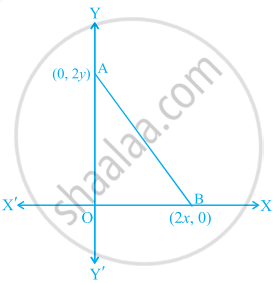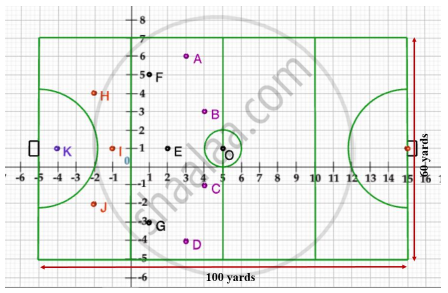Advertisements
Advertisements
Question
If Q (0, 1) is equidistant from P (5, − 3) and R (x, 6), find the values of x. Also find the distance QR and PR.
Solution 1
PQ = QR
= `sqrt((5-0)^2+(-3-1)^2)`
= `sqrt((0-x)^2+(1-6)^2)`
= `sqrt((5)^2+(-4)^2)`
= `sqrt((-x)^2+(-5)^2)`
= `sqrt(25+16) `
= `sqrt(x^2+25)`
41 = x2 + 25
16 = x2
x = ±4
Therefore, point R is (4, 6) or (−4, 6).
When point R is (4, 6),
PR = `sqrt((5-4)^2+(-3-6)^2)`
= `sqrt((1^2+(-9)^2)) `
= `sqrt(1+81)`
= `sqrt82`
QR = `sqrt((0-4)^2+(1-6)^2)`
= `sqrt((-4)^2+(-5)^2)`
= `sqrt(16+25)`
= `sqrt41`
When point R is (−4, 6),
PR = `sqrt((5-(-4))^2+(-3-6)^2)`
= `sqrt((9)^2+(-9)^2)`
= `sqrt(81+81)`
= `9sqrt2`
QR = `sqrt((0-(-4))^2+(1-6)^2)`
= `sqrt((4)^2+(-5)^2)`
= `sqrt(16+25)`
= `sqrt41`
Solution 2
The distance d between two points `(x_1, y_1)` and `(x_2, y_2)` is given by the formula
d = `sqrt((x_1 - x_2)^2 + (y_1 - y_2)^2)`
The three given points are Q (0, 1), P(5, −3) and R(x, 6).
Now let us find the distance between 'P' and 'Q'.
PQ = `sqrt((5 - 0)^2 + (-3-1)^2)`
= `sqrt((5)^2 + (-4)^2)`
= `sqrt(25 + 16)`
PQ = `sqrt(41)`
Now, let us find the distance between ‘Q’ and ‘R’.
QR = `sqrt((0 - x)^2 + (1- 6)^2)`
QR = `sqrt((-x)^2 + (-5)^2)`
It is given that both these distances are equal. So, let us equate both the above equations,
PQ = QR
`sqrt(41) = sqrt((-x)^2 + (-5)^2)`
Squaring on both sides of the equation we get,
41 = (-x)2 + (-5)2
41 = x2 + (-5)2
41 = x2 + 25
x2 = 16
x = ±4
Hence, the values of ‘x’ are 4 or (-4).
Now, the required individual distances,
QR = `sqrt((0 + 4)^2 + (1 - 6)^2)`
= `sqrt((+-4)^2 + (-5)^2)`
= `sqrt(16 + 25)`
QR = `sqrt(41)`
Hence, the length of ‘QR’ is `sqrt(41)` units
For ‘PR’ there are two cases. First when the value of ‘x’ is 4,
PR = `sqrt(82)`
Then when the value of ‘x’ is -4,
PR = `sqrt((5 + 4)^2 + (-3 -6)^2)`
= `sqrt((9)^2 + (-9)^2)`
= `sqrt(81 + 81)`
PR = `9sqrt2`
Hence, the length of 'PR' can be `sqrt(82)` or `9sqrt(2)` units
APPEARS IN
RELATED QUESTIONS
The x-coordinate of a point P is twice its y-coordinate. If P is equidistant from Q(2, –5) and R(–3, 6), find the coordinates of P.
The length of a line segment is of 10 units and the coordinates of one end-point are (2, -3). If the abscissa of the other end is 10, find the ordinate of the other end.
If the point P(x, y ) is equidistant from the points A(5, 1) and B (1, 5), prove that x = y.
Find the distance of the following points from the origin:
(i) A(5,- 12)
Find the distance of the following points from the origin:
(iii) C (-4,-6)
Using the distance formula, show that the given points are collinear:
(-2, 5), (0,1) and (2, -3)
For what values of k are the points (8, 1), (3, –2k) and (k, –5) collinear ?
Find x if distance between points L(x, 7) and M(1, 15) is 10.
The perimeter of a triangle with vertices (0, 4), (0, 0) and (3, 0) is ______.
Find the distance between the following point :
(Sin θ - cosec θ , cos θ - cot θ) and (cos θ - cosec θ , -sin θ - cot θ)
Find the distance of a point (7 , 5) from another point on the x - axis whose abscissa is -5.
Find the coordinate of O , the centre of a circle passing through P (3 , 0), Q (2 , `sqrt 5`) and R (`-2 sqrt 2` , -1). Also find its radius.
ABC is an equilateral triangle . If the coordinates of A and B are (1 , 1) and (- 1 , -1) , find the coordinates of C.
Find the distance between the points (a, b) and (−a, −b).
A point P lies on the x-axis and another point Q lies on the y-axis.
Write the abscissa of point Q.
The points A (3, 0), B (a, -2) and C (4, -1) are the vertices of triangle ABC right angled at vertex A. Find the value of a.
The coordinates of the point which is equidistant from the three vertices of the ΔAOB as shown in the figure is ______.

Case Study -2
A hockey field is the playing surface for the game of hockey. Historically, the game was played on natural turf (grass) but nowadays it is predominantly played on an artificial turf.
It is rectangular in shape - 100 yards by 60 yards. Goals consist of two upright posts placed equidistant from the centre of the backline, joined at the top by a horizontal crossbar. The inner edges of the posts must be 3.66 metres (4 yards) apart, and the lower edge of the crossbar must be 2.14 metres (7 feet) above the ground.
Each team plays with 11 players on the field during the game including the goalie. Positions you might play include -
- Forward: As shown by players A, B, C and D.
- Midfielders: As shown by players E, F and G.
- Fullbacks: As shown by players H, I and J.
- Goalie: As shown by player K.
Using the picture of a hockey field below, answer the questions that follow:

The coordinates of the centroid of ΔEHJ are ______.
What type of a quadrilateral do the points A(2, –2), B(7, 3), C(11, –1) and D(6, –6) taken in that order, form?
The point P(–2, 4) lies on a circle of radius 6 and centre C(3, 5).
